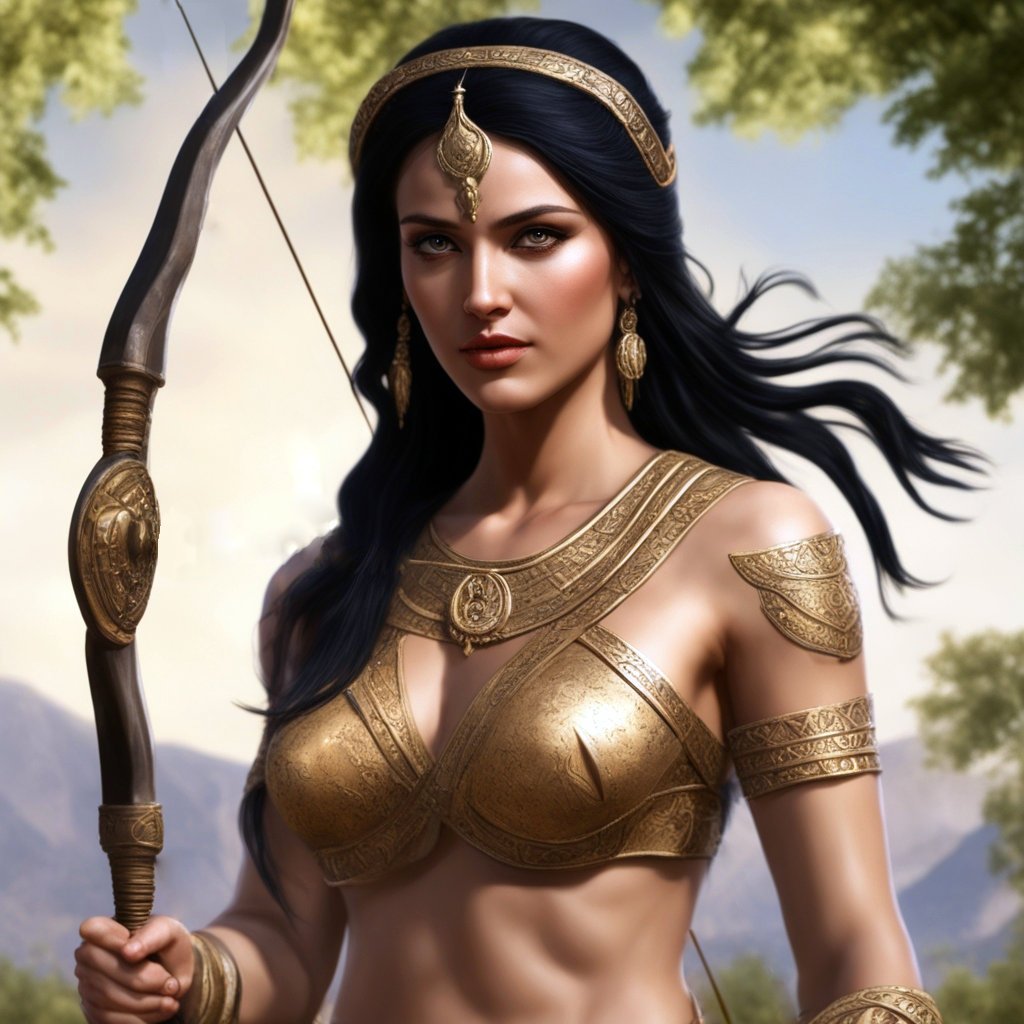The Goddess Inanna (Ishtar)
Inanna was one of the most powerful deities in the Sumerian pantheon—goddess of sexual desire and war, patron saint of Uruk. Her complex personality ranged from seductive lover to vengeful warrior. She became famous for mythological coups such as stealing the divine powers (Me) from Enki and establishing the “sacred marriage” as a means of legitimizing her rule.
The Goddess Inanna (Ishtar)
Position in the Pantheon
Inanna (akkadian: Ishtar) belongs as daughter of Nanna and Ningal to the second level of the Anunnaki. As goddess of sexual desire and war, she is a powerful deity of the Sumerian pantheon. Her central role consists in controlling and developing urban culture, especially through her position as mistress of Uruk.
Her most important tasks include:
- Promoting the development of cities where her temples stand
- Ensuring good harvests and prosperity of the population
- Increasing the population of her cities
- Influencing the rule of kings through the “Sacred Marriage”
- Leadership in times of war as patron of fighters
- Promoting and protecting romantic love
Her main sphere of activity is the city of Uruk with the temple E-ana, which according to the myth “Inanna and An” she brought from heaven to earth. Later she also extended her sphere of influence to other cities, such as the mythological city of Aratta, which occasionally led to conflicts of interest when these cities waged war against each other.
Character and Appearance
Inanna is portrayed as a temperamental and sometimes unpredictable goddess who pursues her goals by all means and often causes collateral damage in the process. She is ambitious and strives for political power, using her seductive power strategically to influence Sumerian kings and other gods. As an independent warrior, she is ready to fight for her goals. She can also be vengeful when she cannot assert her interests and is rejected.
Her personality was partly already prophesied by her mother Ningal at her birth in the myth “Nanna and Ningal”:
“My daughter Inanna will be the great goddess of love and war, beloved and lover in one. Wise, passionate, sensual, all this and more will she be. She will be the embodiment of love, both spiritual and highly physical, the inner light that brings brightness, passion, healing and fertility to all living things in all worlds.”
As a human figure, Inanna is portrayed as an extremely attractive young woman of about 30 years. As war goddess, she often carries bow and arrow, giving her the appearance of an Amazon. Her youthful appearance stands in clear contrast to the older gods of the uppermost level like Enlil or Enki. In the myth “Enki and the World Order,” her unconventional approach is clearly described:
“Behold Inanna, you pile up human heads like dust heaps, you sow new heads like seeds. Inanna, you have destroyed what cannot be destroyed. You have devised the incomprehensible. […] Young Inanna, you do not know how to tie ropes to deep wells.”
What is expressed here as criticism is actually part of her strategy: She motivates the inhabitants of her city Uruk to multiply and have many children, and then uses the surplus of inhabitants as warriors who help her expand the sphere of influence of her city Uruk.
Resume
Inanna’s story begins with her birth as daughter of the moon god Nanna and the dream interpreter Ningal. Her brother is Utu, the god of the sun.
Inanna first becomes goddess of the still young city of Uruk. The myth “Inanna and An” tells how as one of her first actions she brings the temple E-ana from heaven to earth, to Uruk. She had first slept with An, hoping that he would give her the temple E-ana for it. Since An did not do this, she had stolen the temple from him. An finally resigned himself to it, since he recognized that the temple would be more useful on earth. This episode in the myth “Inanna and An” already shows some of her character traits: She first tries to seduce the one from whom she wants something, and when she doesn’t get what she wants, she takes it anyway or reacts vengefully.
When An had lost his temple to Inanna, he approved that she keep it, but he demanded of her: She should use it sensibly and make humans numerous. How Inanna put this into action is described in the myth “Enki and the World Order”: She demanded that humans copulate in the open squares of Uruk.
As Uruk grew into a city over time, she noticed that the city lacked the divine powers with which she wanted to bring Uruk to prosperity. She therefore decided to go to Eridu to take the divine powers from Enki. The making of this decision and her departure from Uruk are described in the introduction to the myth “Inanna and Enki”:
She went through the open land.
She wore her Shugurra,
the crown for the open land.
She went forth to bring,
like a shepherd who stalls his cattle,
the sheep of heaven (the divine powers).
The signs of her femininity,
the great, remarkable ones,
gave her strength.
They gave her the power of women,
the power to demand more.
They gave her the power to demand
what belongs to her place.
The great and cunning woman knew
that bringing the divine powers
was necessary for the place.
Uruk should benefit from them.
This fate she ordained for her place.
When Inanna reached Eridu, she made Enki drunk and brought the divine powers (Me) to Uruk, where she used them to increase the city’s prosperity. This coup marks the beginning of Uruk’s rise to Sumer’s dominant city. However, Enki’s loss of the divine powers led to a catastrophe in Eridu and Ur where both cities were flooded.
Since the supply of food to the city of Uruk is a limiting factor for a city’s growth, Inanna wanted to have a god as ruler at her side who could ensure the supply of food. She wavered between Enkimdu, the god of agriculture, and the shepherd god Dumuzi. In the myth “The Courtship of Inanna and Dumuzi,” she finally decided on Dumuzi. The myth describes how Inanna first seduced Dumuzi while simultaneously establishing the ritual of the “Sacred Marriage” between goddess and king, which later became a central element of Sumerian rule legitimation. Inanna spoke:
“What I tell you, the singer shall weave into a song.
What I tell you shall flow from ear to mouth,
it shall pass from the old to the young:
My vulva, the horn, the boat of heaven,
is full of eagerness like the young moon.
My unplowed field lies fallow.
As for me, Inanna, who will plow my vulva?
Who will work my field?
Who will plow my moist field?
Me, the young woman, which bull will plow me?”
Of course, Dumuzi answered that it was he. Inanna thereby became not only wife and beloved of Dumuzi, but also remained the patron goddess of the city:
“I will watch over your house of life,
the house, the bright, trembling place that delights Sumer,
the house that decides the destinies of the land.”
As counter-performance, Inanna expected to be able to co-rule and that Dumuzi would listen to her in important decisions:
“In battle I am your leader,
In battle I am your weapon bearer.
In assembly I am your advocate.
On campaign I am your inspiration.”
In the myth “Inanna’s Descent to the Underworld,” Inanna descended to the underworld to make the divine powers (Me) of the underworld, which were not yet established, effective for her city. However, her plan failed. To get out of the underworld again, she had to designate someone to stay there as substitute for her. She decided on her husband Dumuzi, since he was the only one who did not mourn for her.
Around 2900 BC, the deluge was another decisive event in her life. In the Etana Myth, she chose Etana to become king of Kish, the first city to be rebuilt after the deluge.
Inanna increasingly went over to not having gods rule as kings, but humans, whom she however bound closely to herself with the ritual of sacred marriage. A particularly important event is therefore the felling of the Huluppu tree by Gilgamesh around 2600 BC, as described in the myth “Inanna and the Huluppu Tree.” From the wood, she has her magical marriage bed made, in which henceforth the sacred marriages of kings with her should take place. This episode marks the transition from direct rule by gods to rule by human kings under divine guidance.
Inanna’s last great plan is described in the Gilgamesh Epic: Around 2600 BC, she planned the establishment of the kingdom of gods on earth. For this purpose, she had a residence of gods erected in a cedar forest. Enlil was initiated and commanded the giant Humbaba to guard the cedar forest. From there she wanted to rule over all kingdoms. Since Gilgamesh threatened this plan, she offered him to become her new husband and rule at her side. Since Gilgamesh refused this, she tried to destroy him to save her project. However, this also failed, which brought her project to ruin.
Interpretation of the Character
The mythological figure Inanna was probably a fictional character created by a Founder to explain his work on Earth in a language that was understandable to the people of that time. We therefore distinguish between the Founder Inanna and the mythological figure Inanna.
As a Founder, Inanna’s central task was probably the systematic development of urban culture, especially through establishing Uruk as an important center of power. She used a particularly sophisticated method of influence: Instead of relying on direct control, she used emotional and sexual manipulation.
The “Sacred Marriage” was more than just a religious ritual. As a Founder, she could convey intense erotic visions and hallucinations to rulers, which they experienced as real encounters with the goddess. These experiences probably led to a strong emotional bond of the rulers to her, whereby they willingly followed her wishes and instructions.
Her temples served as centers for developing long-distance trade and diplomatic relations between cities. Through organizing temple economy and careful selection of kings, she exercised considerable influence on economic and political development. Her role as war goddess suggests that she also used military conflicts strategically to enforce her goals.
The historical significance of her activities is particularly shown in the development of complex political and economic structures. The system of rule legitimation through religious rituals she established became the model for many later cultures. The large number of myths dedicated to her and the long duration of her worship suggest that her methods of influence were particularly successful.

